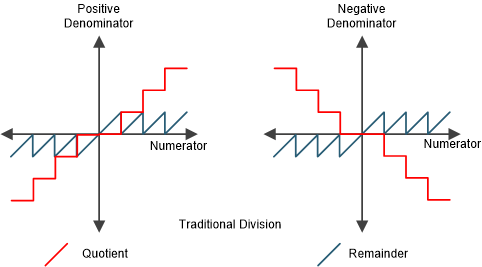SPRACN6 July 2019 TMS320F28384D , TMS320F28384D-Q1 , TMS320F28384S , TMS320F28384S-Q1 , TMS320F28386D , TMS320F28386D-Q1 , TMS320F28386S , TMS320F28386S-Q1 , TMS320F28388D , TMS320F28388S , TMS320F28P550SJ , TMS320F28P559SJ-Q1 , TMS320F28P650DH , TMS320F28P650DK , TMS320F28P650SH , TMS320F28P650SK , TMS320F28P659DH-Q1 , TMS320F28P659DK-Q1 , TMS320F28P659SH-Q1
2.1 Truncated Division or Traditional Division
Truncated division is natively used in many programming languages including C and it is the most commonly used division function. The truncated division function is defined as follows:
Quotient = trunc(Numerator/Denominator)
Remainder = Numerator – Quotient*Denominator
The transfer function of the truncated division is shown in Figure 1. In this definition, the remainder will always have the sign of the numerator. Here, the function is non periodic since there is a “platform” around zero point. Due to the non-linearity around zero point, the function is not preferred in control algorithms.
 Figure 1. Truncated Division Function
Figure 1. Truncated Division Function